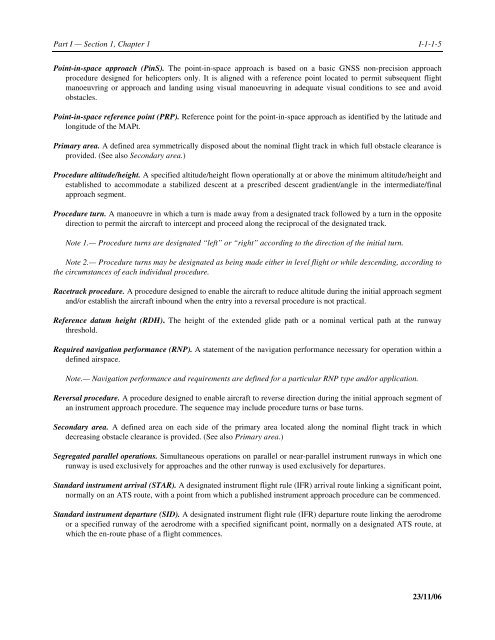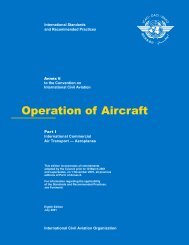Aircraft Operations
Doc 8168 Aircraft Operations, Volume I Flight Procedures
Doc 8168 Aircraft Operations, Volume I Flight Procedures
- No tags were found...
Create successful ePaper yourself
Turn your PDF publications into a flip-book with our unique Google optimized e-Paper software.
Part I — Section 1, Chapter 1<br />
I-1-1-5<br />
Point-in-space approach (PinS). The point-in-space approach is based on a basic GNSS non-precision approach<br />
procedure designed for helicopters only. It is aligned with a reference point located to permit subsequent flight<br />
manoeuvring or approach and landing using visual manoeuvring in adequate visual conditions to see and avoid<br />
obstacles.<br />
Point-in-space reference point (PRP). Reference point for the point-in-space approach as identified by the latitude and<br />
longitude of the MAPt.<br />
Primary area. A defined area symmetrically disposed about the nominal flight track in which full obstacle clearance is<br />
provided. (See also Secondary area.)<br />
Procedure altitude/height. A specified altitude/height flown operationally at or above the minimum altitude/height and<br />
established to accommodate a stabilized descent at a prescribed descent gradient/angle in the intermediate/final<br />
approach segment.<br />
Procedure turn. A manoeuvre in which a turn is made away from a designated track followed by a turn in the opposite<br />
direction to permit the aircraft to intercept and proceed along the reciprocal of the designated track.<br />
Note 1.— Procedure turns are designated “left” or “right” according to the direction of the initial turn.<br />
Note 2.— Procedure turns may be designated as being made either in level flight or while descending, according to<br />
the circumstances of each individual procedure.<br />
Racetrack procedure. A procedure designed to enable the aircraft to reduce altitude during the initial approach segment<br />
and/or establish the aircraft inbound when the entry into a reversal procedure is not practical.<br />
Reference datum height (RDH). The height of the extended glide path or a nominal vertical path at the runway<br />
threshold.<br />
Required navigation performance (RNP). A statement of the navigation performance necessary for operation within a<br />
defined airspace.<br />
Note.— Navigation performance and requirements are defined for a particular RNP type and/or application.<br />
Reversal procedure. A procedure designed to enable aircraft to reverse direction during the initial approach segment of<br />
an instrument approach procedure. The sequence may include procedure turns or base turns.<br />
Secondary area. A defined area on each side of the primary area located along the nominal flight track in which<br />
decreasing obstacle clearance is provided. (See also Primary area.)<br />
Segregated parallel operations. Simultaneous operations on parallel or near-parallel instrument runways in which one<br />
runway is used exclusively for approaches and the other runway is used exclusively for departures.<br />
Standard instrument arrival (STAR). A designated instrument flight rule (IFR) arrival route linking a significant point,<br />
normally on an ATS route, with a point from which a published instrument approach procedure can be commenced.<br />
Standard instrument departure (SID). A designated instrument flight rule (IFR) departure route linking the aerodrome<br />
or a specified runway of the aerodrome with a specified significant point, normally on a designated ATS route, at<br />
which the en-route phase of a flight commences.<br />
23/11/06












